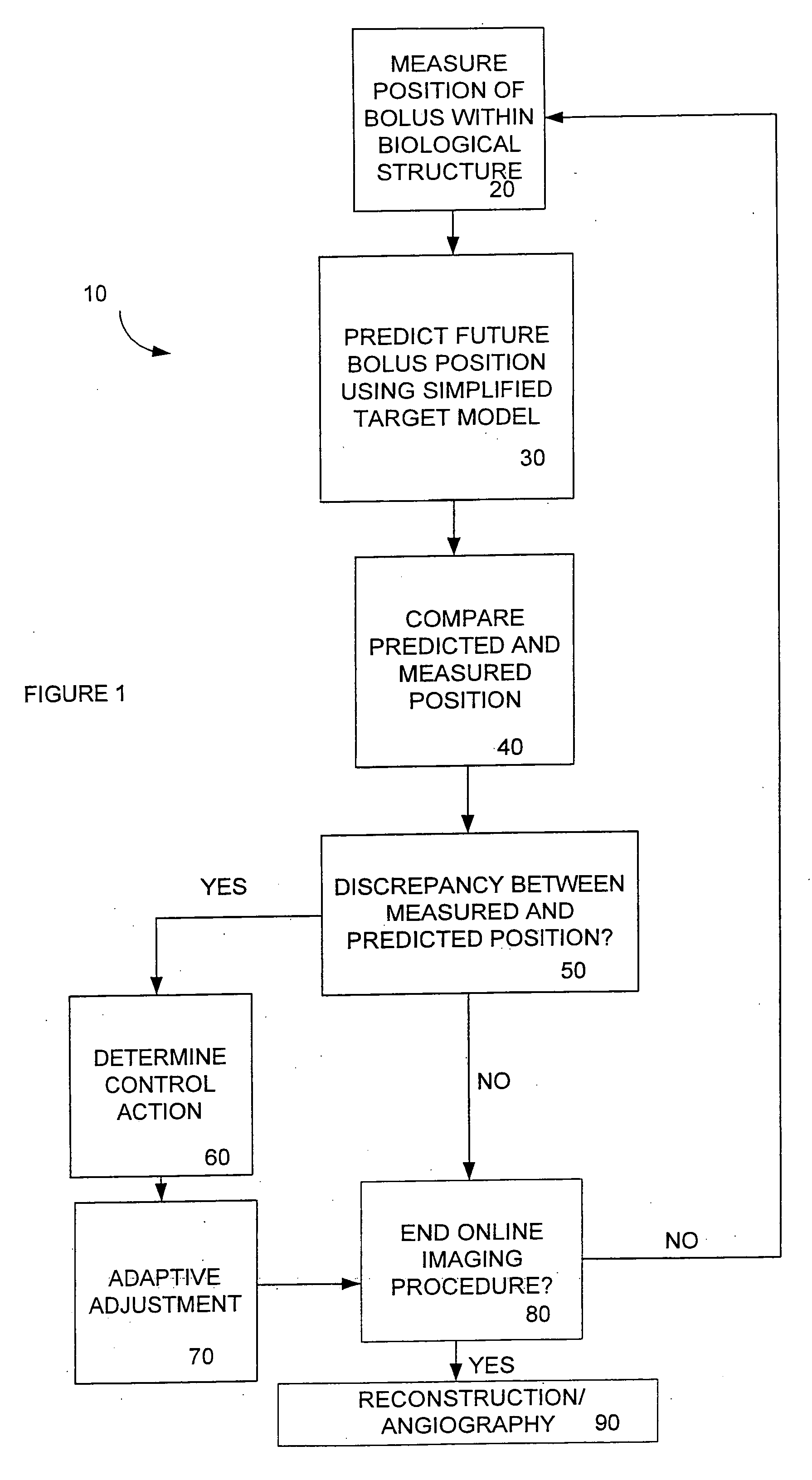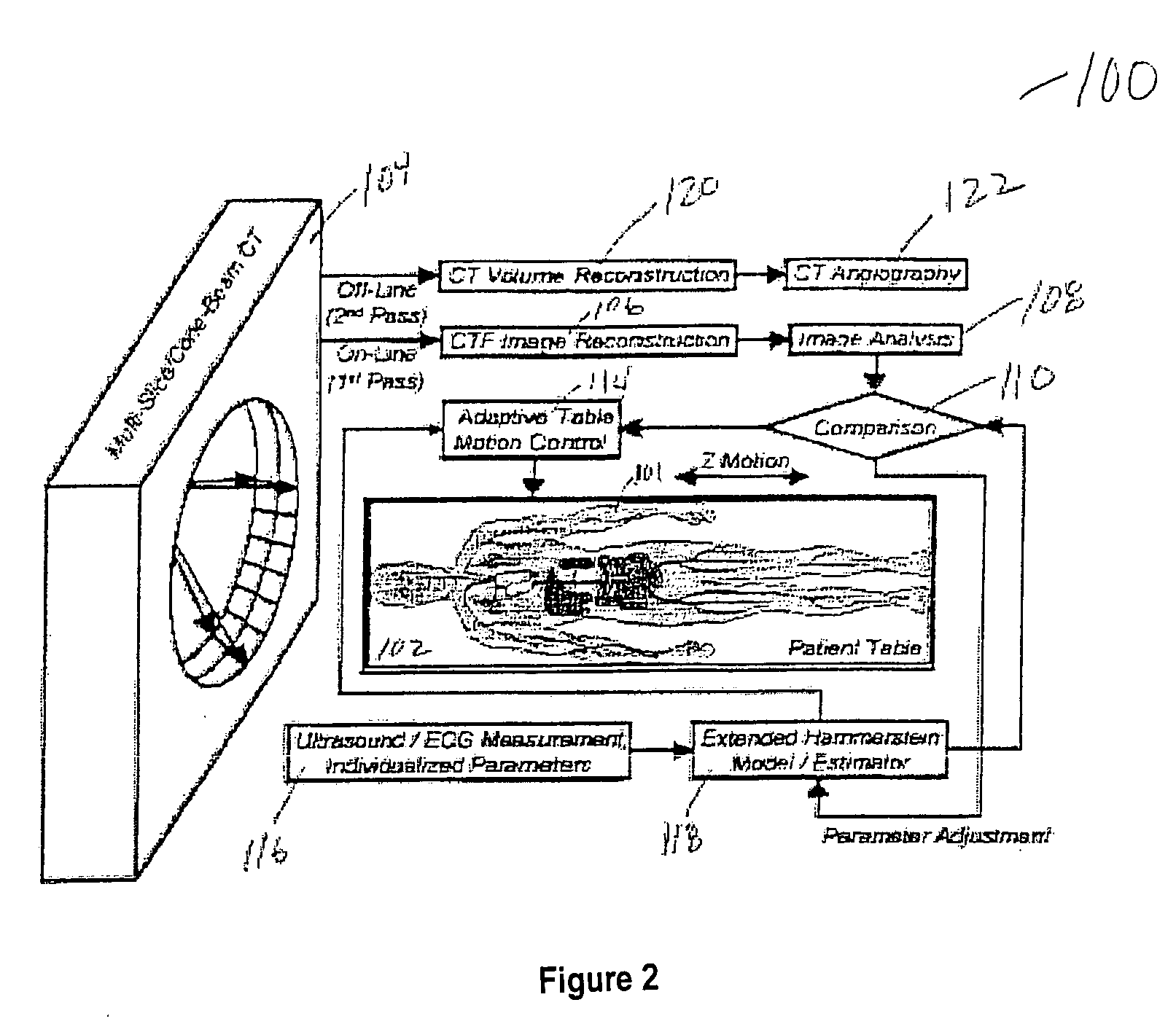System and method for adaptive bolus chasing computed tomography (CT) angiography
a computed tomography and adaptive technology, applied in the field of bolus chasing angiography, can solve the problems of over-estimation of stenosis, overlap of venous structures, and limited results of ct contrast bolus dynamics modeling, so as to achieve faster and more robust identification/estimation algorithms and techniques, and efficient implementation of bolus chasing imaging in practi
- Summary
- Abstract
- Description
- Claims
- Application Information
AI Technical Summary
Benefits of technology
Problems solved by technology
Method used
Image
Examples
example 1
[0105] Adaptive bolus chasing angiography was performed in a computer simulated clinical environment based on published values of blood velocities as shown in Table 1.
TABLE 1PeakMeanVelocityVelocityDiameter ± SD(cm / s)(cm / s)(cm)Aorta (Ao) 150 ± 30 27 ± 8.9 1.8 ± 0.2Common Iliac Artery (CIA) 125 ± NA13.5 ± 4.0 0.9 ± NAExternal Iliac Artery (EIA) 119 ± 21.710.5 ± 5.0 0.79 ± 0.13Common Femoral Artery 114 ± 24.910.2 ± 4.8 0.82 ± 0.14(CFA)Superficial Femoral Artery90.8 ± 13.68.8 ± 3.50.60 ± 0.12(SFA)Popliteal Artery (PA)68.8 ± 3.54.9 ± 2.90.52 ± 0.11Posterior Tibial Artery 61 ± 204.4 ± 3.30.25 ± NA(PTA)Dorsalis Pedis ArteryNA3.6 ± 3.8 0.2 ± NA(DPA)
[0106] Injected contrast bolus was modeled by the above data, future bolus position and shape were predicted based on online-estimated patient parameters, and the patient table was controlled so that the trans-axial imaging aperture was synchronized with the predicted bolus peak position. The mathematical detail of the model used is provided...
example 2
[0112] A non-parametric model was implemented on a prototype CT scanner. This prototype consisted of a PC (personal computer), a Master Flex Pump 7550-30, a movable table controlled by a Vexta alpha stepping motor AS46 and a Pulnix-6700 camera. Plastic tubings configured similar to a patient's aorta and arteries were placed on the top of the table. The variable velocity pump was controlled by the PC and a patient's blood flow was stimulated by driving a bolus through plastic tubings. The velocity was assigned by a computer program. The camera, connected to the PC by a PCI card, provided the real time bolus position that simulated the CT imaging device. The imaging acquiring and processing were carried by NI IMAQ VISION DEVELOPMENT MODULES.
[0113] The model's algorithms were implemented by using the NI Labview software which is widely available. The stepping motor took commands from the PC through a serial port and controlled the table position, thereby simulating a patient table. Th...
example 3
[0114] The above discussed scheme with a non-parametric model was also tested on actual bolus propagation data that were collected from more than 20 patients. FIGS. 9 and 10 show results of two tests. In the figures, the actual bolus peak positions collected from patients are described by dash-dotted lines. The top diagrams are the CT table positions in solid lines using the current constant velocity technology. The bottom diagrams are the CT table positions in solid lines using the scheme discussed in this patent. Clearly, the adaptive bolus chasing CTA performs satisfactorily.
[0115] Unless otherwise expressly stated, it is in no way intended that any method set forth herein be construed as requiring that its steps be performed in a specific order. Accordingly, where a method claim does not actually recite an order to be followed by its steps or it is not otherwise specifically stated in the claims or descriptions that the steps are to be limited to a specific order, it is no way ...
PUM
| Property | Measurement | Unit |
|---|---|---|
| velocities | aaaaa | aaaaa |
| imaging reconstruction algorithms | aaaaa | aaaaa |
| velocity | aaaaa | aaaaa |
Abstract
Description
Claims
Application Information
 Login to View More
Login to View More - R&D
- Intellectual Property
- Life Sciences
- Materials
- Tech Scout
- Unparalleled Data Quality
- Higher Quality Content
- 60% Fewer Hallucinations
Browse by: Latest US Patents, China's latest patents, Technical Efficacy Thesaurus, Application Domain, Technology Topic, Popular Technical Reports.
© 2025 PatSnap. All rights reserved.Legal|Privacy policy|Modern Slavery Act Transparency Statement|Sitemap|About US| Contact US: help@patsnap.com



